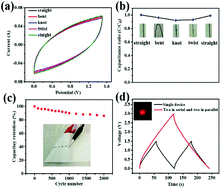From natural cotton thread to sewable energy dense supercapacitors†
Abstract
Considering cost and flexibility, cotton thread is an ideal material for the fabrication of wearable and portable electronics. However, the capacitance of cotton thread based supercapacitors remains extremely low (below 50 mF cm−2) due to the insufficient capacitive utilization of active materials. In this work, ordered mesoporous carbon (OMC) membranes are rationally coupled with chemical vapour deposition derived graphene (CVD gr), to form a highly conductive carbon coating around cotton yarn. In this material design, OMC membranes act as hydrophilic nanoporous “ion reservoirs” to accumulate sufficient cations from a gel electrolyte, while CVD gr endows the composite thread low liner resistance (3.7 Ω cm−1) and high mechanical strength. Using a butyl-3-methylimidazolium chloride modified gel as an ionic conducting electrolyte, the efficiency in capacitive utilization of coated MnO2 microparticles has been doubled, delivering an areal capacitance of 1.1 F cm2 with a volumetric energy of 2.7 mWh cm−3. Such a supercapacitor thread is lightweight, sewable and durable in bending fatigue tests, and can be fabricated through a facile dip-coating method. Impressively, this device can power a photodetector based on TiO2 nanowires without applying any external bias voltage, which opens up a new opportunity for development of wearable and self-powered nanodevices in the near future.



 Please wait while we load your content...
Please wait while we load your content...